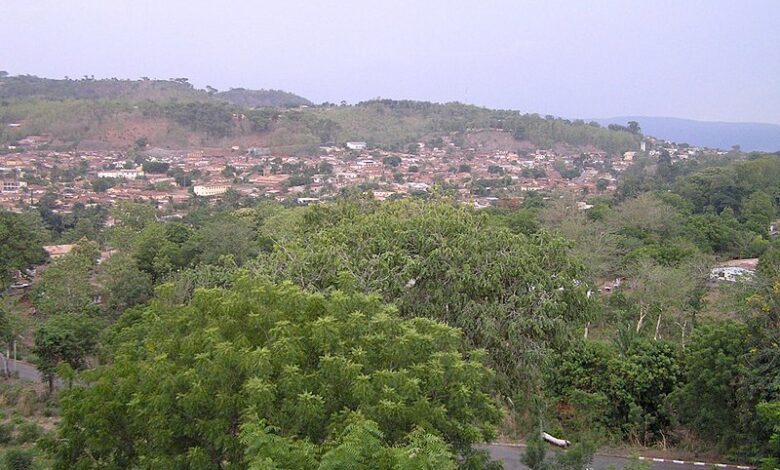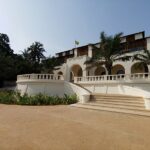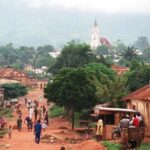Atakpamé

Atakpamé is a city in Togo, West Africa. It is the fifth largest city in the country, with a population of around 85,000 people. Atakpamé is located in the Plateaux Region, about 160 kilometres north of the capital, Lomé.
The city is an important agricultural and commercial center. It is known for its production of cotton, coffee, and cocoa. Atakpamé is also home to a textile factory and a brewery.
The city has a rich history. It was founded in the 19th century by the Ewe people. Atakpamé was an important stop on the caravan route between Lomé and the north. The city was also a haven for refugees fleeing from the Dahomey Kingdom.
Today, Atakpamé is a bustling city with a mix of traditional and modern architecture. The city is home to a number of markets, shops, and restaurants. Atakpamé is also a popular tourist destination, known for its friendly people and its beautiful setting.
Here are some of the things you can do in Atakpamé:
- Visit the Grand Marché, the city’s main market.
- Hike to the top of Mont Agou, the highest mountain in Togo.
- Visit the ruins of Kamina, a former German military base.
- Learn about the Ewe culture at the Musée National d’Atakpamé.
- Attend the Odon-Itsu festival, a traditional yam festival held in July or August.
Map view
More about Atakpamé
| ID |
|---|
| 105159 |
| Name |
| Atakpamé |
| State ID |
| 2577 |
| State Code |
| P |
| State Name |
| Plateaux Region |
| Country ID |
| 220 |
| Country Code |
| TG |
| Country Name |
| Togo |
| Latitude |
| 7.53333000 |
| Longitude |
| 1.13333000 |
| WikiData ID |
| Q126124 |
Atakpamé is the fifth largest city in Togo by population (84,979 inhabitants in 2006), located in the Plateaux Region of Togo. It is an industrial centre and lies on the main north-south highway, 161 km north of the capital Lomé. It is also a regional commercial centre for produce and cloth.
History
Atakpamé is located on a hilly wooded savannah on the eastern end of the Atakora Mountain range, and together with Kpalimé represent the last major settlements of Yoruba origin dotted between the Niger and the Volta rivers. In the 1764 Battle of Atakpamé, the town played host to a clash between the rebellious Akyem vassal state with the help of Yoruba mercenaries of the Oyo Empire and the Dahomeans against the forces of the Ashanti Empire under their Asantehene, Kusi Obodom. In 1763, the Ashante vassal state of Akyem made contact with the Dahomeans to the east while planning a rebellion with other dissident vassal states within the empire, such as the Kwahu and Brong. In the meanwhile, the Bantamahene, one of the Asante senior military officers had been relentlessly pressuring Asantehene Kusi Obodum to crush the building rebellion in war. The Bantamahene Adu Gyamera even went as far as threatening Asantehene's impeachment from power. However The Asantehene ordered no invasions until news reached them that the Akyems had sought out aid from the Oyo Empire. The result of the battle was a crushing defeat of the Ashanti forces and the death of their Juabenhene (head of one of the royal clans). The repercussion of this defeat by the Oyo Empire was the destoolment of Kusi Obodum, who was replaced by a much younger and charismatic Asantehene, Osei Kwadwo.
In 1902, the town was the scene of a scandal in which German Catholic missionaries accused German colonial officials of mistreating girls. The scandal had reverberations in German politics. In 1914, during World War I, the British and French invaded the German colony of Togoland during the Togoland Campaign. It was aimed at capturing or destroying a powerful German radio station at Kamina near Atakpamé. The Allies feared that German maritime raiders would be able to maintain contact with Berlin via the station and thus rapidly pass on intelligence. A short campaign began on 6 August 1914, and the Germans were forced to destroy the station on 24 August before surrendering to the Allies on 26 August.
It was during this campaign that Alhaji Grunshi fired the first shot by anyone in British service during the war. Most native residents of the city are the Ana subgroup of the Yoruba people.
During Colonization the German colonial government built a wireless transmitter center in Kamina at Atakpamé from 1911 to 1914 in the Togolese colony. This transcontinental radio station served as a link for the German colonies among themselves and to establish a connection between these colonies and the German metropolis.
Climate
Atakpamé has a tropical savanna climate (Köppen Aw) characterised by a short dry season with the northeasterly harmattan trade winds from November to February and a lengthy though not intense wet season between March and October.
Transport
The town was once served by a station of the main northern line of Togo Railways.
Governance
The town was the administrative centre of German Togoland.
Places of worship
Among the places of worship, they are predominantly Christian churches and temples : Roman Catholic Diocese of Atakpamé (Catholic Church), Evangelical Presbyterian Church of Togo (World Communion of Reformed Churches), Togo Baptist Convention (Baptist World Alliance), Living Faith Church Worldwide, Redeemed Christian Church of God, Assemblies of God. There are also Muslim mosques.
Sports
Atakpamé is the home of Korikossa d'Atakpamé football club.
International relations
Twin towns — Sister cities
Atakpamé is twinned with:
- Niort, France
Sources
- Fage, J.D. and Roland Oliver (1975). The Cambridge History of Africa Volume 4 c. 1600 - c. 1790. Cambridge: Cambridge University Press. p. 811. ISBN 0-521-20981-1.
References
References
- http://www.britannica.com/EBchecked/topic/40371/Atakpame
- https://www.dwd.de/DWD/klima/beratung/ak/ak_653760_kt.pdf
- ftp://ftp.atdd.noaa.gov/pub/GCOS/WMO-Normals/TABLES/REG__I/TG/65376.TXT
- http://www.ghanaweb.com/GhanaHomePage/features/Asante-History-Akyem-Abuakwa-And-Dagomba-Wars-271133
- https://books.google.com/books?id=4G7Xv-wapEMC&q=atakpame+yoruba&pg=PA36
- https://books.google.com/books?id=MdaAdBC-_S4C&q=yoruba+in+atakpame&pg=PA28
- https://www.wikidata.org/wiki/Q126124#identifiers
- https://catalogue.bnf.fr/ark:/12148/cb136223459
- https://data.bnf.fr/ark:/12148/cb136223459
- https://viaf.org/viaf/159503165

